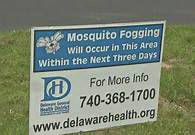
The Delaware General Health District has reported an Ashley resident had contracted La Crosse Encephalitis (LAC).
“La Crosse Encephalitis is a rare illness caused by a virus transmitted to human populations by the bite of a mosquito,” said Traci Whittaker, public information officer. “Currently there are no vaccines or antibiotics that are effective against LAC.”
Whittaker added that the most important measure to prevent the transmission of the disease is by controlling the surrounding environment. She said dumping standing water is the most effective way in controlling the mosquito population.
“The most common mosquito associated with LAC is the Aedes Triseriatus or the ‘Treehole Mosquito,’” Whittaker said. “Symptoms typically occur 5-15 days after a person is exposed. Symptoms of LAC include vomiting, nausea, headache, fever and fatigue. In cases where the disease is more serious, seizures, coma, paralysis and brain damage can occur with a mortality rate of less than 1 percent.”
Whittaker said LAC is in a group of illnesses that can cause severe complications including death. She said all ages can be affected, but children are at risk the most.
“We are always concerned about people with weakened immune systems such as young children and older adults,” she said.
Whittaker said when a mosquito-borne disease is discovered in a human, “our staff go door-to-door informing residents in the area about the prevention of the mosquito-borne disease,” she said. “Crews assess the particular area where there is standing water and add larvicide if needed. Fogging then takes place in the evening shortly thereafter.”
The Health District fogged Ashley for mosquitoes July 19.
Whittaker said another type of encephalitis common to the Central Ohio Area is St. Louis Encephalitis (SLEV).
“All ages can be affected, but typically elderly are most at risk,” she said. “St. Louis Encephalitis is transmitted through the bite of an infected mosquito. The most common mosquito associated with St. Louis Encephalitis is the Culex species.”
Whittaker said mosquitoes contract SLEV from infected birds and then transmit it to humans. Most people infected with SLEV don’t show any symptoms. She said symptoms usually manifest in 5-15 days after exposure.
“Typical symptoms of St. Louis Encephalitis include headache and fever,” Whittakers said. “More severe symptoms include headache, high fever, neck stiffness, stupor, disorientation, coma, tremors, occasional convulsions and spastic paralysis.”
.neFileBlock {
margin-bottom: 20px;
}
.neFileBlock p {
margin: 0px 0px 0px 0px;
}
.neFileBlock .neFile {
border-bottom: 1px dotted #aaa;
padding-bottom: 5px;
padding-top: 10px;
}
.neFileBlock .neCaption {
font-size: 85%;
}


